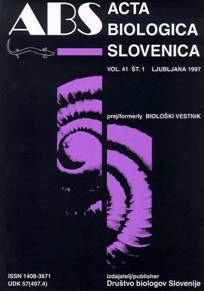|
 |
Contents (Abstracts)
Volumes
11: 1 (1963)
27: 2 (1979)
31: 1 (1983)
35: 1 (1987)
36: 1 (1988)
40: 3-4 (1995)
42: 2 (1999)
43: 3 (2000)
44: 1-2 (2001)
45: 2 (2002)
46: 1 (2003)
47: 1 (2004)
47: 2 (2004)
48: 1 (2005)
48: 2 (2005)
49: 1 (2006)
49: 2 (2006)
50: 1 (2007)
50: 2 (2007)
51: 1 (2008)
51: 2 (2008)
52: 1 (2009)
52: 2 (2009)
53: 1 (2010)
53: 2 (2010)
54: 1 (2011)
54: 2 (2011)
55: 1 (2012)
55: 2 (2012)
56: 1 (2013)
56: 2 (2013)
57: 1 (2014)
57: 2 (2014)
58: 1 (2015)
58: 2 (2015)
59: 1 (2016)
59: 2 (2016)
60: 1 (2017)
60: 2 (2017)
61: 1 (2018)
61: 2 (2018)
62: 1 (2019)
62: 2 (2019)
63: 1 (2020)
63: 2 (2020)
64: 1 (2021)
64: 2 (2021)
65: 1 (2022)
65: 2 (2022)
Contents:
Volume 49, Nr. 2 (2006)
The RepFIIA replicon of the natural Escherichia coli plasmid pRK100
STARČIČ ERJAVEC Marjanca, ŽGUR-BERTOK Darja
Abstract
The aim of the presented study was to identify the similarity of the plasmid pRK100 RepFIIA replicon (replication region) with similar replicons of other known plasmids of Enterobacteriaceae. For this purpose, within the determined nucleotide sequence of pRK100, the RepFIIA replicon rep genes/regions were identified. The nucleotide sequences of the pRK100 determined rep genes/regions were subsequently compared with the nucleotide sequences of other RepFIIA replicon rep genes/regions deposited in Genebank. Further, the nucleotide divergence between them was calculated. The obtained results clearly demonstrated, that the individual pRK100 rep regions are the same/most similar to rep regions from different plasmids. RepA2 of pRK100 is most similar to repA2 of pCP301, pINV_F6_M1382, pWR501 and R1, copA is the same as copA of plasmids pC15-1a and R100, repA6 of pRK100 is the same as repA6 in plasmids pC15-1a, pCP301, pINV_F6_M1382, pWR501, R1 and R100, repA1 is most similar to repA1 of the plasmid p1658/79, and repA4 of pRK100 is most similar to repA4 of pC15-1a. Hence, the composition of the pRK100 RepFIIA replicon is mosaic and unique among the plasmids.
Keywords
plasmid, RepFIIA replicon, Enterobacteriaceae, nucleotide divergence |
Colicins of the Escherichia coli uropathogenic strain collection
STARČIČ ERJAVEC Marjanca, RIJAVEC Matija, ŽGUR-BERTOK Darja
Abstract
110 uropathogenic Escherichia coli (UPEC) strains were screened for colicin production and 42 (38%) of the tested UPEC strains were found to be colicinogenic. The ColA, ColB, ColD, ColE2, ColE3, ColE4, ColE5, ColE6, ColE7, ColIa, ColIb, ColK, ColN, MccB17, ColS4, MccC7 and ColE6-J colicin producer strains from Pugsley's collection of colicinogenic strains were lysed by all colicinogenic UPEC strains, the ColM and ColE1 producer strains by 93% of the UPEC colicinogenic strains and the ColV producer strain by only 81% of the UPEC colicinogenic strains. 67% of the colicinogenic UPEC strains were able to lyse all 20 used colicin producer strains and 33% of the colicinogenic UPEC strains were able to lyse 19 Pugsley's strains. Hence, a majority (67%) of the studied UPEC strains encode and produce either more than one colicin, or a colicin not tested. Colicins of UPEC strains producing only one colicin were identified; 8 strains (19% of the colicinogenic strains) produced only ColV, 3 strains (7%) ColM and 3 strains (7%) ColE1. Plasmids were found in 88% of the colicinogenic strains. 11 DL strains were found to harbour conjugative plasmids encoding antibiotic resistance(s) and colicinogenicity. Further, 19% of the haemolytic UPEC strains and 44% of non-haemolytic strains were also colicinogenic, 28% of the cnf encoding strains and 41% of the strains not encoding cnf were colicinogenic, while 40% of ibeA encoding strains and 38% of strains not encoding ibeA were colicinogenic.
Keywords
colicin, uropathogenic Escherichia coli, UPEC, plasmid, haemolysin, hly, cytotoxic necrotising factor, cnf, invasin, ibeA |
Quantitative analysis of the macroinvertebrate community in the river Temenica (SE Slovenia)
PUST Mojca, TOMAN Mihael J.
Abstract
Macroinvertebrate community of the river Temenica was investigated in order to asses the ecological quality of the stream. Different approaches were used in order to compare their usefulness. Surber sampler methodology was used and all together16 quantitative samples were taken at four stream reaches every three months from October 2003 until July 2004. Saprobic and diversity indices showed severe deterioration of water quality longitudinally and a strong negative influence of the town Trebnje on the ecological state of the river Temenica. Multivariate methods DCA and CCA confirmed those results, but also showed greater differences in community structure at sampling site 1 compared to sites 2 and 3 which was not detected using the indices.
Keywords
macroinvertebrates, water quality assesment, saprobic index, diversity indices, DCA, CCA |
|



